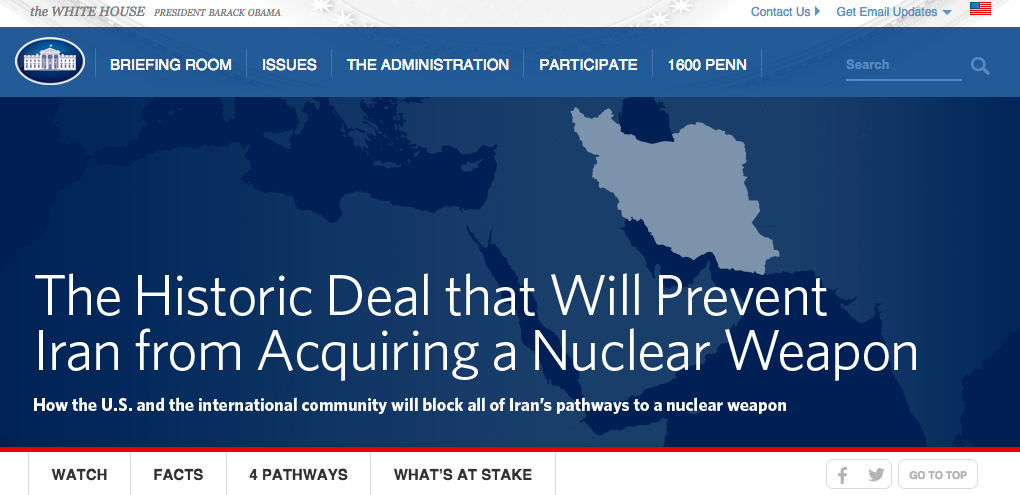Check Out The White House's New 'Iran Deal' Twitter Handle
The White House's PR Strategy on the Iran Deal
LONDON: The world is divided on the nuclear deal between Iran and the P5+1 (namely China, France, Russia, the United Kingdom, and the United States, plus Germany). While a large part of the world has welcomed the deal, it’s critics remain. Foremost amongst the latter are (unsurprisingly) Israel and within the US itself, the Republicans. As news broke of the deal being inked, many wondered how President Barack Obama would respond to the critics. Since then Obama’s strategy has been unveiled, with the White House launching a new PR campaign Tuesday morning with a website and a Twitter account aimed at providing information on the nuclear deal with Iran.
The website (https://www.whitehouse.gov/issues/foreign-policy/iran-deal) and the Twitter handle (https://twitter.com/TheIranDeal) display facts, infographics, quotes, statistics, videos -- all relating to the Iran nuclear deal.
"Get the facts on the #IranDeal," the Twitter bio for @TheIranDeal reads. "Tweet us your questions, and we'll set the record straight."
At the time of writing, the account had 9021 followers and 9 tweets.
The website has a number of facts and videos, such as an answer to the question: “"Anytime, anywhere" inspections sound good. Why doesn’t this deal require those?” “Under this deal, Iran will allow robust monitoring of all its nuclear facilities. IAEA inspectors have the right to a physical or technical presence in all of Iran’s nuclear sites and will conduct regular monitoring of Iran’s entire nuclear fuel cycle and supply chain, from uranium mines and mills to centrifuge production, assembly, and storage facilities,” clarifies the answer.
“Building a nuclear bomb requires either uranium or plutonium. But thanks to this deal, Iran’s four possible ways to leverage those fissile materials are blocked,” states a section on the four pathways of the deal.
“From the minute materials that could be used for a weapon comes out of the ground to the minute it is shipped out of the country, the IAEA will have eyes on it and anywhere Iran could try and take it,” it continues.
A section on “What Iran’s Nuclear Program Would Look Like Without This Deal?” states: “As it stands today, Iran has a large stockpile of enriched uranium and nearly 20,000 centrifuges, enough to create 8 to 10 bombs. If Iran decided to rush to make a bomb without the deal in place, it would take them 2 to 3 months until they had enough weapon-ready uranium (or highly enriched uranium) to build their first nuclear weapon. Left unchecked, that stockpile and that number of centrifuges would grow exponentially, practically guaranteeing that Iran could create a bomb—and create one quickly – if it so chose. This deal removes the key elements needed to create a bomb and prolongs Iran’s breakout time from 2-3 months to 1 year or more if Iran broke its commitments. Importantly, Iran won’t garner any new sanctions relief until the IAEA confirms that Iran has followed through with its end of the deal. And should Iran violate any aspect of this deal, the U.N., U.S., and E.U. can snap the sanctions that have crippled Iran’s economy back into place.”
It outlines the difference the deal makes in a nifty infographic.
While it may seem like the White House is wasting its time and PR effort in pushing a deal that has already been arrived it, in reality -- the United States Congress has 60 days to consider the deal. If Congress rejects it, Obama has promised a veto, but with a two-thirds majority Congress will be able to override it.
Although that two-third majority may be hard to pull off, Obama doesn’t want to take any chances. More so as Israel continues to stand opposed to the deal and with presidential elections round the corner, Republican candidates are lining up to tear the Iran Deal apart -- Obama’s PR strategy is to ensure the longevity of the deal in such a way that that tearing apart remains theoretical.





